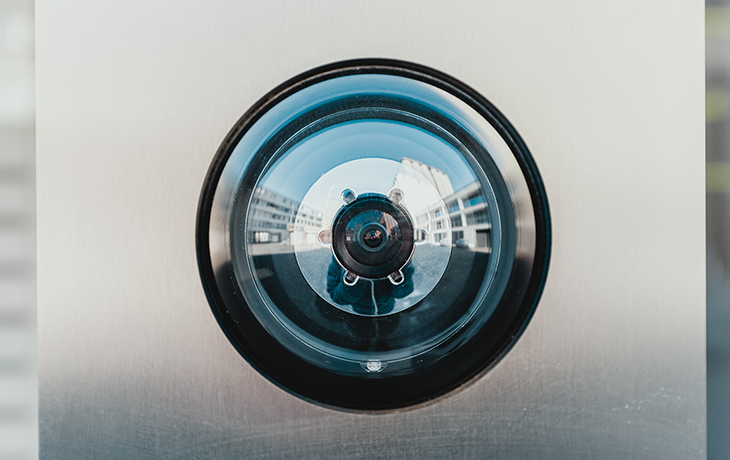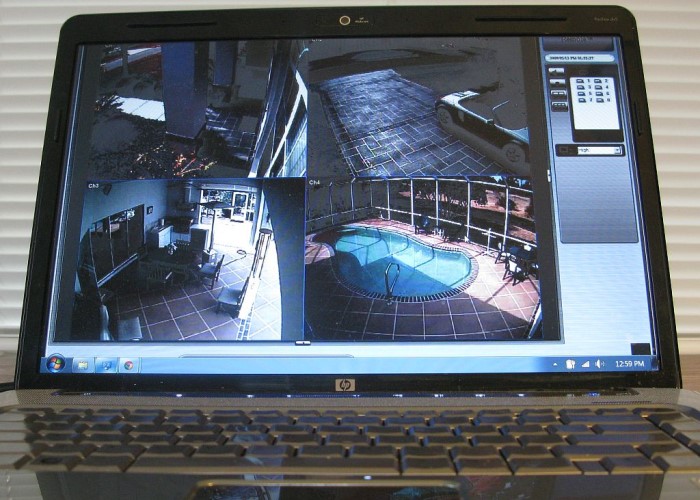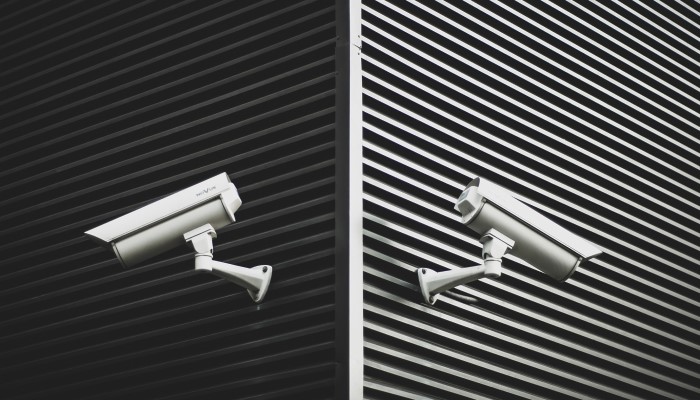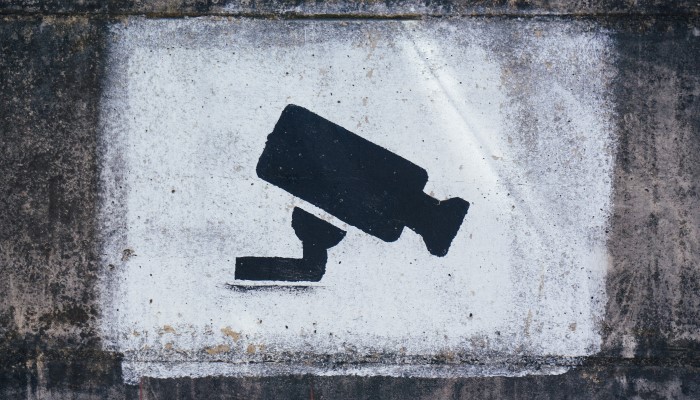Security cameras can keep track of what goes on inside the home or they can alert you to a stranger roaming around your yard at night. They can also record footage to send to law enforcement, so should a crime occur on your property, you’ll be able to resolve it as quickly as possible.
That said, cameras are just one layer of a home’s security system. All the bells and whistles in today’s cameras make them extremely valuable on their own, but to get the most bang for your buck, combine them with other layers like lighting and alarm systems.
More: Easy ways to harden your home against intruders and best window bars
You should decide if you want cameras as part of an overall alarm system — so that the cameras and other alarm components work together in harmony — or do you just want a stand-alone camera that records video/audio and (maybe) sends an alert to your phone when it detects motion.
If you want more of an overall system, check out the best alarm systems and consider how the pieces play nicely together (or don’t). You wouldn’t want to install a bunch of Google Nest cameras and then later decide you want an alarm that only works with Amazon Alexa. Although there’s a bit of overlap, this guide focuses more on cameras that are good for stand-alone uses.
The most important bits:
- Security cameras work! Studies have shown that 50% of thieves will abandon their break in if they spot a camera.
- Indoor cameras are great for checking on kids, elderly parents, and pets — but don’t use a camera outdoors unless it’s specifically labeled as an outdoor/weatherproof camera.
- It’s important to think about wired vs. wireless power, wired vs. wireless data, and whether the data is stored locally in your home or ‘in the cloud.’ Those choices will have the biggest impact on what you buy.
- Security cameras can be triggered by motion or set to record constantly.
- Security cameras usually work in day and night. For night recording, the camera may be augmented with infrared LED lights to brighten the area.
- Don’t expect your camera to create a perfect picture of an intruder’s face. They often cover their head/face, and regardless, cameras often don’t record super-high levels of detail.
- There are cameras that record in higher resolutions like 4K, but it eats up so much data bandwidth that most people record in 1080p. This definitely matters when the data is stored in the cloud since you’d essentially be uploading 4K video 24/7, choking your connection and likely earning surcharges from your ISP.
- Some cameras are smart enough to tell the difference between a human and anything else.
- Some can even recognize specific people, but that usually requires a subscription plan and reducing privacy settings.
- You might get an insurance break because your home is now safer. If bad things do happen, cameras make insurance claims and law enforcement much easier and more successful.
- Before you purchase a camera system — especially ones with free cloud storage — check the privacy policy. Your recordings may be used by a company for research, marketing, fraud detection, and quality control. The video may also be shared with other companies or the police.
While we haven’t done head-to-head field testing of enough cameras to make a “scientific” pick yet, these recommendations are based on our experience, research, and consumer reviews:
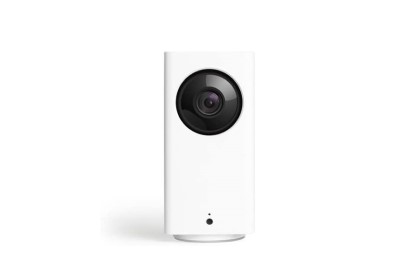
Indoor camera:
Wyze Cam Pan
This little camera is packed with high end features and is fairly inexpensive when compared to similar cameras. Uses your home WI-FI to connect to the Wyze application on your mobile device.
Using the Wyze app you can pan, tilt and zoom the camera in real time. The camera can pan 360 degrees left and right and tilt up and down 93 degrees. It also has 8x digital zoom. If something catches your eye, you can easily change the camera angle or zoom in to see it.
You can also program the camera to scan up to 4 defined sectors in a room to locate pets.
The camera shoots in 1080p HD video with a 120-degree field of view and night vision capability, so you’ll see everything you need to see at the proper resolution.
It can also integrate with Amazon Alexa, Google Assistant, and IFTTT.
Wyze provides 14 days of cloud storage for free. If you want to store locally, Wyze also offers a model that has Micro SD storage capability.
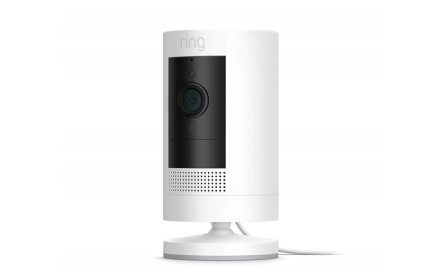
More versatile indoor camera:
Ring Stick Up Cam Plug-In
Ring Stick Up cameras offer a lot of flexibility when it comes to power sources. The Stick Up cameras come in battery, solar powered and AC powered options. Because the company is owned by Amazon, Ring is compatible with Alexa, IFTTT, and Z-Wave. The cameras can be added to the Ring suite of security products or simply used as cameras.
Like Wyze cameras, Ring cameras are capable of motion detection, and can also set “privacy zones” for areas you don’t want to record.
With an IPX5 weather rating, these cameras can be used indoors or outdoors, and can function at temperatures from -5 F to 122 F. They can be mounted to a wall or simply placed on a flat surface. A lot of cameras on the market are sensitive to temperature.
Unfortunately, Ring does not offer free storage. For storage you will need to purchase a Ring Protect Plan. These allow for video storage, video sharing, and video download. Ring offers three levels of these “protect plans:” the Basic, Plus, and Pro. The Basic Protect Plan costs $4 per month or $40 per year and only allows you to record video for one camera. The Plus tier costs $10 per month or $100 per year and allows for all the cameras you want and gives you extended warranties on those devices. Pro starts out at $20 per month or $200 per year and gives you 24/7 professional security monitoring, ability to connect your cameras to a cellular network if your home WiFi goes out, and everything the Plus and Basic levels give you.
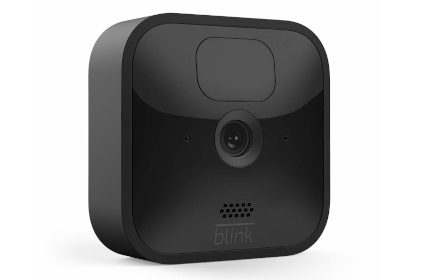
Great for Alexa homes:
Blink Outdoor
The Blink Outdoor is a sleek, simple, rugged wireless camera that is easy to install and will last 2 years on the included two AA lithium batteries. The cameras were designed for outside use, but will also work indoors.
Blink Outdoor records in 1080p HD video, and has night vision capabilities, motion sensing, and live streaming through the Blink app. It does require a wifi connection to work, but when connected, Blink will send alerts if your camera picks up motion.
This kit includes the Blink Sync Module. The Sync Module coordinates your Blink devices with your Blink mobile application.
Without a subscription, you can receive motion activated alerts and live view streaming up to 5 minutes. The Blink Basic Plan is $3 per month or $30 per year and gives you 90 minutes of live view streaming, and video and photo recording and sharing for one device. The Blink Plus Plan for $10 per month or $100 per year gives you everything in the Basic plan but for unlimited devices and gives you extended warranty coverage.
If you want to avoid the monthly subscription fee, for $35 you can add the Blink Sync Module 2 which allows you to attach an up to 256GB flash drive and record videos and photos locally. Those then can be accessed through the Blink app on your phone.
The only drawback with the Blink Outdoor is that only smart home capability is with Amazon Alexa. It won’t integrate with Google or Apple systems.
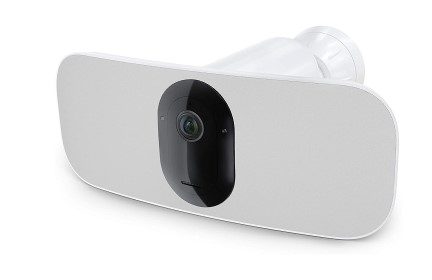
Camera and floodlight combo:
Arlo Pro 3 Floodlight Camera
Arlo makes premium indoor and outdoor cameras that are geared towards the smart home market. Their products work with Amazon Alexa, Google Assistant, Apple Home, Kit, and IFTTT.
The Arlo Pro 3 Floodlight Camera is unique because it blends a high end wireless camera with a 2,000 lumen spotlight. Other features:
- 2-way audio. (Communicate with people outside your home. Delivery guy, kids, etc)
- Color night vision
- 2k resolution and video/160 degree field of view/12x zoom feature/auto track features
- Wireless – Batteries will last 6 months. Arlo 3 assembly can be removed and charged via USB cable. Solar panel is available. Arlo also sells a magnetic charging cable if you want to keep your device constantly plugged into an energy source.
- Stream a live view or watch recorded clips from a mobile device
- Smart Siren can be triggered automatically or manually from the Arlo app.
- Alerts and motion detection. Custom alerts for people and vehicles
- Use an Arlo SmartHub or Base Station to synchronize with other Arlo products.
- 3000 lumen capability with the use of magnetic charging cable.
Sign up for an Arlo Smart Plan to take advantage of the 2k recording, 30-Day Video history (storage), advanced object detection, package detection, person detection, specific activity zone monitoring, and intelligent alerts you need to subscribe to the Premier Plan. The Premier plan costs $2.99 a month for a single camera and $9.99 for up to 5 cameras.
Be prepared. Don’t be a victim.
Want more great content and giveaways? Sign up for The Prepared’s free newsletter and get the best prepping content straight to your inbox. 1-2 emails a month, 0% spam.
Contenders
Although not the top picks, these were close contenders that you might want to browse while shopping:
- Abode Iota – Central hub/camera/siren/motion detector that can also control your smart home. Will require a plan for video storage and monitoring. Good value if you are looking more for a camera, that borders on a home security system.
- Arlo Pro 3 – Excellent indoor/outdoor camera, but it needs a hub if you want to use more than one camera. If you just need one camera, not a bad idea to pay extra and get the Arlo 3 with a floodlight.
- Canary View Indoor Security Camera – Nice camera, but lacked the versatility of our other picks.
- Nest – Google Nest Camera. Awesome camera, but the Wyze provided a little more value. If you already have a suite of Google Nest products, get the Nest.
- Reolink Argus 2E – Nice camera. Solar panel is a nice upgrade. Felt the blink Outdoor was more versatile due to compact size and 2 year battery life. Will require a plan for storage.
- Ring Floodlight Camera – Nice, but Arlo 3 with floodlight is wireless, and more versatile. Gorgeous industrial design. If you already have Ring products, go with this one.
Dividing up the market
We spend our days surrounded by cameras on our phones and computers, in our workplaces and at traffic lights and at home. So what exactly makes a security camera different from these other cameras? It’s the function, really. When we talk about a security camera, we’re usually referring to a camera (or a series of cameras) positioned around a property to monitor what’s going on there. That’s the simple definition.
One easy way to divide up the market is to think about indoor and outdoor cameras and the different functions they serve.
Indoor cameras include baby monitors, pet cameras, hidden cameras (or “nanny cams”), and mounted, visible surveillance cameras. Indoor cameras let you know what’s going on inside the home. They’re used to find out if something strange, dangerous, or inappropriate happens while you’re away or occupied.
Outdoor cameras include doorbell cameras and cameras mounted for monitoring points of entry like doors and windows. They’re used to capture the people who visit your home and the actions they take before they enter.
The industry in general seems to be making camera models that can be used both indoors and outdoors, but we recommend using each camera to record either indoors or outdoors.
It’s worth making the distinction because some people wonder if an indoor camera can work as an outdoor security camera if they point it out a window. That’s not such a silly question. Outdoor cameras are typically more robust and have better weatherproofing than indoor cameras. By putting a camera inside and pointing it out a window, it’s tempting to think you’d add a layer of security.
It’s a pretty bad idea to point a camera out a window, however. Window glass can get in the way of the camera’s job and distort the image. That image distortion from glass could make motion detection and night vision capabilities fail. Better to use outside cameras and place them where people can’t reach them.
We point this out because indoor and outdoor cameras can serve different needs. Thinking through your family’s needs before you buy a security camera (or two) will help you take advantage of your camera’s design and key features. An easy place to start is by deciding if you want indoor cameras, outdoor cameras, or both.
What a security camera should do
The point of buying a security camera is twofold:
- See what’s going on when you’re not around.
- Have a recording of anything sketchy to hand over to law enforcement.
So the camera you choose should be able to serve those main functions, whether the camera goes inside or outside. This makes cameras a multi-purpose tool to have in your home security network.
Security cameras aren’t one size fits all, and that’s how it should be. Every family and every home has different needs. In today’s market, though, there are a few things any good camera should have to really do its job.
When shopping for a camera, you can look for these features to make sure you’re purchasing something that’s worth the money:
- Easy configuration. A security camera should be able to work with a computer program, mobile application, or Alexa, Apple, or Google Home. Smartphone applications make setup and programming a lot easier.
- Weather resistance. If you plan to place a camera outdoors, it should have an IP65 or IPX5 rating.
- Adjustable motion-activation. This common feature lets you set the sensitivity of your sensors. Most people don’t want wind, trees, birds, and other wildlife to set off notifications, since the camera is intended for security.
- Resolution. Security cameras can range from 720p to 1080p in resolution. There are even 2k and 4k security cameras. For most people, somewhere between 720p and 1080p is the sweet spot. At this resolution, you won’t use a lot of bandwidth or storage space. No matter the resolution you get, know that security cameras are notoriously bad for identifying criminals. That’s not the cameras’ fault. Intruders often wear hooded sweatshirts, hats, glasses, or masks to conceal their identity.
- Field of view. Wider field of view may not always be better because the wider you go, the less detail you get. The majority of cameras range from 90 to 160 degrees. If you need greater detail, or only need to monitor a front porch or entryway, a narrow field of view is fine.
- Smart home integration. A lot of cameras are specific to only one suite of products. Look for products that work with Amazon Alexa, Google Assistant, Apple HomeKit, Z-Wave and IFTTT.
When choosing a camera, it’s really less a question of how much you should spend, and more a question of making sure you have the essential safety features and enough cameras to cover your main entry points.
Do you just need an indoor camera, or do you need an outdoor camera to cover your front door? Do you have a large property that will require several cameras? Then you might consider going with some additional features, which you can find down the page.
Where should a security camera go?
Since the vast majority of home intruders enter through the first floor, it is logical to place cameras where those intruders could try to enter: the front doors, back doors, and ground floor windows.
State and local laws vary, but most places in the United States say you can record video on your property. Not everywhere, however, allows you to record audio without consent. Some jurisdictions require that you post a sign saying you are recording.
For cameras to really work, they should be kept out of reach. That way an intruder won’t be able to take them down, destroy, or disarm them. Placing a camera at least 9 feet of the ground is ideal.
Whether indoor or outdoor, make sure the doors, windows, and any other entry points are within view. You might also be interested in placing cameras outdoors around your yard or toward the street. As a general rule, any place that is considered public can be monitored. That said, it’s almost always a bad idea to point a camera in the direction of a neighbors’ property.
If you live in a rental apartment, make sure to check with the landlord and rental agreement before installing a camera.
Optional features that can improve security
Once you have the main features covered and a plan for cameras to be installed out of reach, you’re most of the way there. The following optional features can help your security network go the extra mile:
Integration with your existing security system. If you already have a security system, check with your security company to see what cameras, if any, your system is compatible with. Security systems from SimpliSafe, ADT, Google Nest, Ring, Vivant, Link, and Abode offer indoor cameras that work flawlessly with their security systems.
Pan, Tilt and zoom functionality. From an application, you might be able to zoom, adjust, pan, or tilt the camera in real time.
Motion sensing. If you don’t want 24/7 recorded footage, this is the feature to look for. When a camera detects motion it will start recording, and in some cases alert you. Some outdoor cameras will have an accompanying light that turns on. Look for cameras where you can set the motion boundaries.
Two-way audio. Allows you to communicate with delivery people, strangers at the door, or a parent or child inside the home.
Night vision. If you want to monitor 24/7 you will need a camera with night vision capabilities. These cameras are usually augmented with Infrared LED lights.
Facial recognition. This is an emerging technology that will alert you if a certain person is in your home or outside your door. This technology creates a database of everyone the camera has recognized in or around your home.
Note: A lot of people have (reasonable) privacy concerns around this technology. It’s starting to become more common if you do want it, but it’s not essential.
Choosing a power source
There are two categories of power sources for security cameras. Wireless cameras are powered by batteries or a solar panel. Wired cameras are plugged into an outlet or a hardwired into your home. Both have a use case.
Wireless: for renters or those who want flexibility
Wireless setups with batteries and solar offer a lot of flexibility.
A wireless setup is ideal for people who rent. Landlords may not want you drilling into the walls, so batteries and solar panels are your friend.
Wireless cameras that rely on batteries can last a long time — anywhere from 6 months to 2 years on one set of batteries.
Wired: for those who want increased reliability and resolution
Wired cameras are physically powered by electrical cords. They send their video data through a cable. Wired cameras can also connect to the internet via an ethernet cable for cloud storage.
A benefit of wired cameras: they can be a tad more reliable. Because of their wiring, unlike wireless cameras, they are not prone to electromagnetic interference. Wired cameras also tend to provide a better image.
Unfortunately, wired cameras are also more complicated to set up. They often require professional installation.
Storing footage in the cloud or locally
Anyone who has a computer today knows the basic difference between cloud storage and local storage. Your computer can keep information stored on its hard drive (locally) or online through a service like Google, Dropbox, or Apple (in the cloud).
Cloud storage gives you more room for data and the ability to access your data from any device.
Local storage tends to be cheaper and can feel more secure because there’s only one way to access your data.
Security camera storage works much the same way. You can either store video or images through your service provider or on an SD card installed directly into the camera.
Most of today’s cameras use Wi-Fi to transmit footage to a cloud based server, but they can also store footage locally on an SD card. When you opt for cloud storage, recordings go into the cloud where they can be viewed by any internet-connected device. You can watch live feeds or motion-activated recordings from your office, the grocery store, or while in transit.
Wireless cameras need a strong internet connection for 4k video. If wifi goes down, most cameras won’t transmit data to the cloud, though they could keep recording on local storage.
In remote areas without easy access to the internet and electricity, cameras that rely on SD cards and batteries are ideal. Sometimes you just need to record the comings and goings of a property to look back on later.
It’s important to be aware that any wireless system you set up inside your home could be vulnerable to hacking. That includes your computer and smartphone, as well as any smart home systems like Google, Alexa, and Apple products.
Mobile devices make our lives easier and more convenient, but they also allow companies to garner information about our purchasing habits and behavior. Security cameras interface with mobile devices, so it’s very possible that companies also study the data security cameras provide.
Those risks aren’t enough for most people to abandon modern life and cameras entirely. Instead, think of your security tech as part of a larger security network that includes other home-hardening measures like solid locks, screws, and lights.
Tip: Make sure to update firmware, change passwords, and use two-factor authentication if your camera system allows it. You can also follow these best practices to keep your data as safe as possible:
- Check the privacy agreement at each security company before you purchase their products.
- Remember that companies that offer free cloud storage may look at your stored footage.
- Disable recording indoors, or make sure cameras are not filming the private places in your home.
- Study the security settings in your mobile application and adjust accordingly.
- If you’re really nervous about securing your footage, bypass the cloud and store video to a DVR or SD Card.
